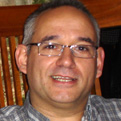de Sá, Rafael

Rafael de Sá
Dr. Rafael Omar de Sá is a Professor of Biology at the University of Richmond. His research aims to fill the gaps in our knowledge surrounding one particularly enigmatic group of amphibians – the ‘humming frogs,’ technically known as Chiasmocleis, which is the largest genus of the narrow-mouthed frog family found in the Neotropics. His lab collaborates with U.S. and South America, Europe, and African labs. In addition to the anurans research program, his lab works with the University of Uruguay to understand the evolutionary biology of annual fishes.
Larson, P. and R. O. de Sá. 1998. Chondrocranial morphology of Leptodactylus larvae (Leptodactylidae: Leptodactylinae): its utility in phylogenetic reconstruction. Journal of Morphology, 238:287-305.
de Sá, R. O. and C. Swart. 1999. Development of the suprarostral plate of pipoid frogs. Journal of Morphology, 240:143-153.
Camargo, A., de Sá, R. O. and W.R. Heyer. 2006. Phylogenetic analyses of mtDNA sequences reveal three cryptic lineages in the widespread neotropical frog Leptodactylus fuscus (Schneider, 1799) (Anura, Leptodactylidae). Biological Journal of the Linnean Society, 87: 325-341.
de Sá, R., W.R. Heyer, and A. Camargo. 2005. A phylogenetic analysis of Vanzolinius (Amphibia, Anura, Leptodactylidae): Taxonomic and life history implications. Arquivos do Museu de Historia Natural do Rio de Janeiro, 63(4):1-20.
Frost, D., R., T. Grant, J. Faivovich, R. H. Bain, A. Haas, C. F.B. Haddad, R. O. de Sá, A. Channing, M. Wilkinson, S.C. Donnellan, C. J. Raxworthy, J. A. Campbell, B. L. Blotto, P. Moler, R. C. Drewes, R. A. Nussbaum, J. D. Lynch, D. M. Green, and W. C. Wheeler. 2006. The amphibian tree of life. Bulletin of the American Museum of Natural History. 297:1-370, +71 figs, 5 tbls, 7 Append.
Rafael Omar de Sá was born and raised in Montevideo, Uruguay. He attended Liceo 23, Sayago, Montevideo, Uruguay, for high school and completed his undergraduate degree in biology from the University of Uruguay in 1984. Because of his deep passion for studying anurans, a sub-classification of amphibians that includes frogs and toads, he attended the University of Kansas Department of Ecology & Evolutionary Biology for his master’s degree, which he completed in 1986. He went to the University of Texas, Austin where he earned a zoology doctorate in 1991.
After earning his Ph.D., Dr. de Sá completed postdoctoral work at the Plum Island Animal Disease Center from 1991 to 1992. In 1992 he was hired as an assistant professor in biology at the University of Richmond. He was named a distinguished educator at the University of Richmond and promoted to Associate professor. He was promoted to full professor in 2004. He taught biology, anatomy, evolution, and other lab-based courses.
Dr. de Sá’s lab researches the evolutionary biology of anurans, molecular and morphological phylogenetics, systematics, taxonomy, and development. The lab actively works and collaborates with several labs around the world. This includes regular reciprocal visits to other U.S, South America, Europe, and Africa labs. The relationships and lab exchanges provide unique academic and cultural exchange opportunities. Dr. de Sá also studies the evolutionary biology of annual fishes through the University of Uruguay.
Since 1994, Dr. de Sá has been an adjunct research associate at the United Nations Sciences Teaching Science Department Program in Uruguay, supporting their graduate program. Since 1995 he has also been an adjunct research associate at the Division of Amphibians and Reptiles at the Smithsonian Institution.
Starting in 2007, Dr. de Sá has been the co-chair of the International Union Conservation of Nature-Amphibian Species Specialist (IUCN-ASS) for Uruguay. From 2009 to 2011, he was the program director for the National Science Foundation’s Systematic and Biodiversity Science Cluster. Since 2010, Dr. de Sá has been a research associate at the National Museum of Natural History in Uruguay. From 2013 to 2014, he was the Fulbright Distinguished Chair at the University of Sao Paulo.
Dr. de Sá has published over 100 journal articles, many with his undergraduate and graduate students. He regularly presents his work and advises national and international organizations. He has been recognized with dozens of awards for his work, including a Distinguished Visiting Professorship from the National Museum of Natural History in Paris in 2007.
Dr. de Sá mentioned a few mentors he had throughout his career, including Raul Vaz Ferreira, Nibia Berois, and Annelise Gerhau from the Univ. of Uruguay; Linda Trueb Williamn and E. Duellam of the Univ. of Kansas; and David M. Hillis of the Univ. of Texas at Austin. He has mentored many graduate and undergraduate students at the University of Richmond in the last 30 years.
“A. Think and choose careful your commitment to a given career path. B. Develop long-term relations with your fellow graduate students/colleagues. C. Secure funding to pursue your goal or passion. D. Establish goals every few years (4-5) to pursue” (Survey, 2023).
University of Richmond. 2023. Dr. Rafael O. de Sá. Retrieved June 29, 2023, from https://biology.richmond.edu/faculty/rdesa/
Curriculum Vitae. August 2013. Rafael Omar de Sá. https://assets.richmond.edu/files/faculty-staff-bio/as/desa_CV.pdf
Survey and interviews conducted by Justice, Equity, Diversity, and Sustainability Initiative staff. 2022-2023. Yale University-School of the Environment. New Haven, Connecticut.